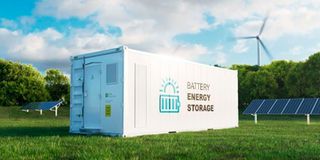Kenya aims big in energy storage amid expanded output

A battery energy storage. The question of power storage has become critical as Kenya embraces e-mobility which requires reliable power supplies.
The Energy and Petroleum ministry targets to mainstream power storage in its electricity master plan as the country’s renewable energy generation expands.
Demand for industrial battery systems is being driven by increasing reliance on intermittent energy sources such as wind and solar power and the potential to add energy to the grid quickly when power needs spike.
The ministry said the country’s medium-term power generation and transmission masterplan is set for review to among other things capture the capacity for electricity storage.
“Assess the need for electricity storage capacity, compare the possibilities available, identify the challenges and scope of the different aspects to be covered to support the implementation of suitable storage projects (e.g. regulatory, pricing methodology, etc)” it said in a tender call for consultants.
This comes amid a gradual shift by Kenya towards the utility-scale Battery Energy Storage Systems (BESS) technology concepts which have picked up pace globally as renewable energy generation expands.
The Energy Ministry in its Least Cost Power Development Plan 2021-2030 (LCPDP) includes BESS as a key in supporting the integration of variable renewable energy technologies and system support.
Its projects a BESS capacity of 50 megawatts (MW) in 2022 and gradually rise to 250MW by 2030.
“Introduction of BESS helps to optimise the system by increasing the load during the off-peak and providing peaking capacity. Solar projects proposed as hybrids with storage components may be given priority in the selection of intermittent capacity as they can assist in system stabilisation” the ministry says in its LCPDP.
Several firms including Kenya Power and a host of other privately owned ones have already rolled out plans for BESS projects.
Kenya Power last year announced plans to set up a grid-level 100 MW lithium-ion BESS by 2024 to store power at low demand to be used during peak power demand.
The utility firm said the system will store idle power generated by intermittent sources such as wind and solar when power demand is at a low level and inject it into the national power grid over four hours at peak demand before the batteries are recharged.
Kenya Power projected that more than 480MW of BESS are required across different locations in the country, such as western Kenya, where there is inadequate transmission capacity at peak times as well as at substations along Kenya’s coast.
Separately on September 9, 2019, the US Trade and Development Agency awarded a grant to Kenya’s Craftskills Energy Limited for a feasibility study by an American firm, Delphos International for the development of a 50MW wind power plant with integrated battery storage capacity in Kenya.
In addition to a wind resource assessment and plant design, the study team was mandated to explore a battery energy storage solution that would enhance the capacity of the power plant and stabilise the intermittency of wind power to the grid with a result that more power would be delivered to consumers at a competitive cost.
In 2020, developers under a public-private partnership (PPP) broke ground for the construction of a Sh15 billion 80Mw renewable power project in Meru County with a battery storage component.
The hybrid project dubbed ‘the Meru County Energy Park’ will be a large-scale facility that combines wind, solar PV, and battery storage. On completion, the facility is expected to feature up to 20 wind turbines and more than 40,000 solar panels.
The PPP project is a joint owned by the Meru County government, global renewable energy developers, Windlab, and c, a subsidiary of Toyota Tsusho Corporation.





